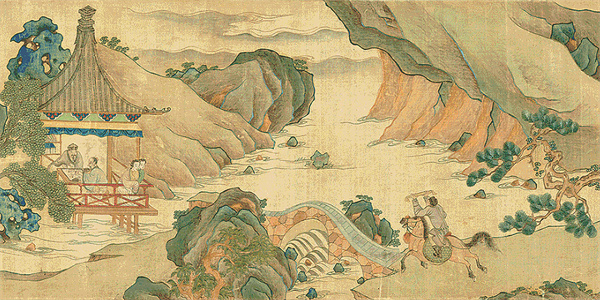

Editor's note: From a place of exile to a cultural and economic powerhouse, the influence of Jiangnan still echoes in China today. The next three pages will take you on a journey through this verdant land's eternal poetry, art and spirit.
Two benign-looking gentlemen are playing chess under the roof of a little stilted pavilion, which itself is embedded in a picturesque landscape complete with verdant mountains and meandering streams. At one with their game, the men, occupying the left side of an embroidered canvas, stand in contrast with their two female companions who are leaning against the railing, apparently having found something more worthy of their attention.
From the other side of the picture, a courier has galloped into view on a stallion, the flailing tail and flared nostrils of which suggest a frantic ride. The man is holding, with both of his raised hands, what appears to be a scroll.
It indeed is a scroll, a written one containing a message of such importance to the Eastern Jin Dynasty (317-420) that it is comparable to the one delivered by the legendary courier Pheidippides to his fellow Athenians who were waiting for news from the Battle of Marathon.
The soldiers of Eastern Jin had just routed their enemies from the north, who outnumbered them by almost twofold. The battle, which took place in the winter of 383, secured in Chinese history the place of one man — Xie An, upon whose strategy the front-line commanders of the Eastern Jin army had acted and to whom the news of victory was delivered, in a classic moment when a seemingly unflappable Xie clashed with a friend on a chessboard.
It also helped to prevent any pillaging that could have happened to the adopted seat of power of the Eastern Jin, founded by a key member of the ruling family of the Western Jin Dynasty (265-316) who crossed the Yangtze River from the north with his supporters in 317.
"The relocation of the Jin court, from central China to the southern region known as Jiangnan, was propelled by the harassment and invasions of the steppe empires from the north," says Clarissa von Spee, curator of the exhibition China's Southern Paradise: Treasures from the Lower Yangzi Delta, on view at the Cleveland Museum of Art in the US city of Cleveland, Ohio.
Jiangnan, which literally translates into "land south of the (Yangtze) river", sits on the southern part of that delta. With more than 240 exhibits drawn from museums worldwide, the grand display intends to explain the land's remarkable transformation — from a fringe area where unenlightened locals wore "truncated hair and heavy tattooing" to quote from an ancient piece of literature, to a fertile ground that served as a cultural and economic powerhouse.